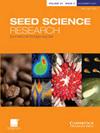Investigation of flavonoid expression and metabolite content patterns during seed formation of Artemisia sphaerocephala Krasch.
IF 2.1
3区 生物学
Q2 PLANT SCIENCES
引用次数: 3
Abstract
Abstract Flavonoids are a group of phenolic secondary metabolites in plants that have important physiological, ecological and economic value. In this study, using the desert plant Artemisia sphaerocephala Krasch. as the sample material, the content and components of the total flavonoids in its seeds at seven different developmental stages were determined. In addition, the genes involved in flavonoid metabolism were identified by full-length transcriptome sequencing (third-generation sequencing technology based on PacBio RS II). Their expression levels were analysed by RNA-seq short reading sequencing, to reveal the patterns and regulation mechanisms of flavonoid accumulation during seed development. The key results were as follows: the content of total flavonoids in mature seeds was 15.05 mg g−1, including five subclasses: flavonols, chalcones, flavones, flavanones and proanthocyanidins, among which flavonols accounted for 45.78%. The period of rapid accumulation of flavonoids was 40–70 d following anthesis. The high expression of phenylalanine ammonia-lyase (PAL), 4-coumarate-CoA ligase (4CL) and UDP-glucose:flavonoids 3-o-glucosyltransferase (UF3GT) promoted the accumulation of total flavonoids, while the high expression of flavonoids 3′-hydroxylase (F3′H) and flavonols synthase (FLS) made flavanols the main component. Transcription factors such as the MYB-bHLH-WDR (MBW) complex and Selenium-binding protein (SBP) directly regulated the structural genes of flavonoid metabolism, while C2H2-type zinc finger (C2H2), Zinc-finger transcription factor (GATA), Dehydration-responsive element binding (DREB), Global Transcription factor Group E protein (GTE), Trihelix DNA-binding factors (Trihelix) and Phytochrome-interacting factor (PIF) indirectly promoted the synthesis of flavonoids through hormones such as brassinoidsteroids (BRs) and abscisic acid (ABA). These results provided valuable resources for the application of related genes in genetics and breeding.沙蒿种子形成过程中黄酮类化合物表达及代谢产物含量模式的研究。
摘要黄酮类化合物是植物中一组酚类次生代谢产物,具有重要的生理、生态和经济价值。本研究采用沙漠植物沙蒿为材料。以其种子为试材,测定了七个不同发育阶段种子中总黄酮的含量和成分。此外,通过全长转录组测序(基于PacBio RS II的第三代测序技术)鉴定了参与类黄酮代谢的基因。通过RNA-seq短阅读测序分析了它们的表达水平,以揭示种子发育过程中类黄酮积累的模式和调控机制。主要结果如下:成熟种子中总黄酮含量为15.05 mg g−1,包括黄酮醇、查尔酮、黄酮、黄烷酮和原花青素五个亚类,其中黄酮醇占45.78%。苯丙氨酸解氨酶(PAL)、4-辅酶A连接酶(4CL)和UDP-葡萄糖:黄酮类化合物3-邻葡萄糖基转移酶(UF3GT)的高表达促进了总黄酮的积累,而黄酮类化合物3′-羟化酶(F3′H)和黄酮醇合酶(FLS)的高表现使黄烷醇成为主要成分。转录因子如MYB-bHLH-WDR(MBW)复合物和硒结合蛋白(SBP)直接调节类黄酮代谢的结构基因,而C2H2型锌指(C2H2)、锌指转录因子(GATA)、脱水反应元件结合(DREB)、全局转录因子E组蛋白(GTE),三螺旋DNA结合因子(Trihelix)和植物色素相互作用因子(PIF)通过类油菜素类固醇(BRs)和脱落酸(ABA)等激素间接促进黄酮类化合物的合成。这些结果为相关基因在遗传学和育种中的应用提供了宝贵的资源。
本文章由计算机程序翻译,如有差异,请以英文原文为准。
求助全文
约1分钟内获得全文
求助全文
来源期刊

Seed Science Research
生物-植物科学
CiteScore
3.60
自引率
4.80%
发文量
23
审稿时长
>12 weeks
期刊介绍:
Seed Science Research, the official journal of the International Society for Seed Science, is a leading international journal featuring high-quality original papers and review articles on the fundamental aspects of seed science, reviewed by internationally distinguished editors. The emphasis is on the physiology, biochemistry, molecular biology and ecology of seeds.
 求助内容:
求助内容: 应助结果提醒方式:
应助结果提醒方式:


